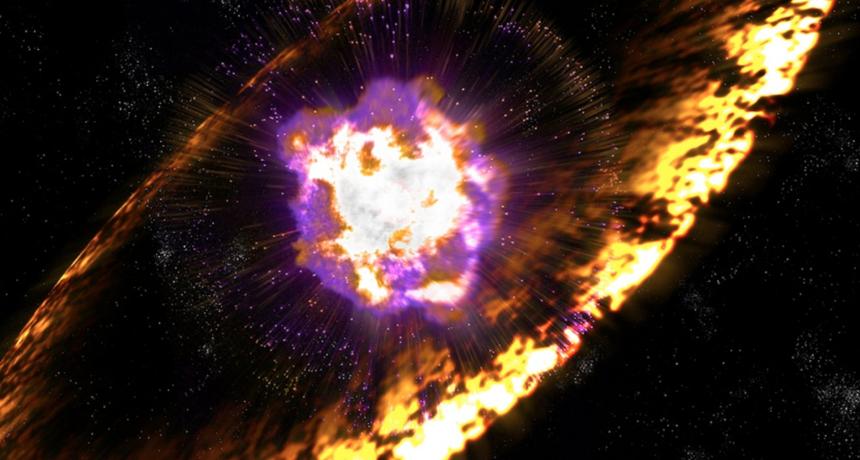Where cosmic rays are born
New evidence links origin of these very energetic particles to massive explosions of distant stars

Here we go! Shock waves in the clouds of gas surrounding an exploding star (as in this artist’s depiction) accelerate charged particles called protons to very high speed, creating cosmic rays.
Greg Stewart/SLAC Nat'l Accelerator Lab
By Sid Perkins
About 100 years ago, researchers discovered a large numbers of very small particles slamming into Earth’s upper atmosphere at high speeds. The mystery particles arrived from all directions. They came from an unknown source apparently outside our solar system. Scientists called them “cosmic rays.”
Now, a century later, a team of scientists has found the origins of most cosmic rays. They are born from clouds of gas surrounding the ancient and massive explosions of distant stars.
About 90 percent of cosmic rays are high-speed protons. Protons are subatomic particles, or one of the three main particles that form atoms. Protons carry a positive charge.
Many cosmic rays travel at nearly the speed of light, which is nature’s speed limit. As they travel, cosmic rays don’t follow a direct path. That is because our galaxy’s magnetic fields steer charged particles in many different directions. So by the time cosmic rays arrive at Earth, researchers cannot simply trace them back in a straight line to their origin.
Still, experts have long had hints about the source of cosmic rays. For instance, scientists knew that strong magnetic fields can accelerate, or speed up, charged particles, says Stefan Funk. He’s an astrophysicist (a scientist who studies the processes that occur inside and around stars) at Stanford University in Palo Alto, Calif.
Only a few types of events could generate cosmic rays in quantities that would match the numbers that scientists were counting, says Funk. Black holes are one such event. Massive explosions of dying stars are another. These exploding stars, called supernovae, are extremely rare. In our entire Milky Way galaxy, only three or four supernovae occur each century. But when these stars do blow up, watch out! Each supernova can briefly shine with a billion billion times the energy emitted by our sun.
The same processes in supernovae that generate cosmic rays also produce a very strong type of radiation called gamma rays. Because gamma rays are a type of light, magnetic fields in our galaxy do not affect their paths. That means that scientists can trace gamma rays straight back across space and pinpoint their origin, says Funk. But Earth’s atmosphere blocks most of the gamma rays that arrive from distant stars. So researchers gather gamma-ray data using telescopes in orbit.
Funk and his colleagues used those telescopes to look at the gas clouds surrounding two supernovae. The supernovae lie about 5,000 and 9,500 light-years from Earth, respectively. While the supernovae exploded thousands of years ago, telescopes can still spy light from the remnants of the explosions. These supernovae unleashed plenty of gamma rays. And an unusually large fraction of those gamma rays had especially high energies. That’s a sign that the strong magnetic fields in the shock wave, created in each explosion, accelerated protons to high speeds, says Funk.
Other types of charged particles wouldn’t have generated the same pattern of gamma ray energies. That fact points to the outwardly expanding debris of exploded stars as the source of the fast-moving protons we call cosmic rays, Funk says. The team reported its results on Feb. 14 at the American Association for the Advancement of Science in Boston. The experts also published the results the same week in Science.
Scientists have studied in the laboratory the pattern of gamma ray energies that might be produced in the gas clouds surrounding supernovae, says Patrick Slane. He’s an astrophysicist at Harvard University in Cambridge, Mass. The new analysis by Funk and his team “is strong evidence” that most cosmic rays are produced in the remnants of supernovae, he says.
Although only a few supernovae explode in our galaxy each century, the gas clouds produced by each event can generate cosmic rays for about 10,000 years, Slane notes. So even though the stellar explosions are rare, they still are plentiful enough to produce all the cosmic rays that scientists now observe.
Power Words
astrophysicist A scientist who studies the nature and properties of stars and other celestial bodies.
cosmic rays Very high-energy particles, mostly protons, that bombard Earth from all directions. These particles originate outside our solar system.
gamma rays High-energy radiation often generated by processes in and around exploding stars. Gamma rays are the most energetic form of light.
proton A positively charged particle found in the nucleus, or center, of every atom.
supernova (plural supernovae) A very large exploding star. In our Milky Way galaxy, about three or four supernovae explode every 100 years.
supernova remnant The clouds of gas and debris surrounding a star that exploded long ago. The strong magnetic fields inside these remnants accelerate protons to very high speed, creating cosmic rays.







